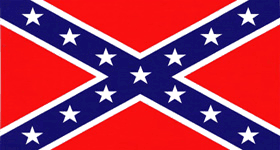 |
Civil War Battles |
|
State War Records |
| AL - AK - AZ - AR - CA - CO - CT - DE - FL - GA - HI - ID - IL - IN - IA - KS - KY - LA - MA - MD - ME - MI - MN - MS - MO - MT - NE - NV - NH - NJ - NM - NY - NC - ND - OH - OK - OR - PA - RI - SC - SD - TN - TX - UT - VT - VA - WA - WV - WI - WY |
The Battle of Chusto-Talasah/ Caving Banks
December 9, 1861 in Chusto-Talasah, Oklahoma
 |
|||||||||||||||||||||
|
Troops of Union and Confederate Indians met in battle infrequently during the war, but one of the more notable engagements occured at Bird Creek. With the coming of war, many Creeks and Seminoles adhered to the Union, and one of the Confederacy's prime objectives, once it had organized in Indian territory, was the dispersal or elimination of these "tories". Led by Chief Opothleyahola and Halleck Tustenuggee, the pro-Union Crreks and Seminoles, numbering about 1,000 able-bodied men, clustered on the Canadian River in the heart of Creek country.
As early as November 15, Col. Douglas H. Cooper led some 1,400 Southern soldiers against the Indians but found them gone. Pursuing, he met and defeated them at Round Mountain on the 19th but was forced to allow them to escape. By December 8, Opothleyahola and his band were camped at Bird Creek in the heart of the Cherokee Nation. Fearing that the Unionist Indians would attack, Cooper decided to take the offensive himself.
Believing the Indians to number 2,000 or more, Cooper marched in 2 columns, arriving late on the 8th. Opothyeahola had sent a message saying that he wanted peace, not a fight. Cooper responded, saying that he agreed. A meeting was proposed for the next day, and Cooper started bedding his men down for the night. Apparently many of the Indian warriors were tired of running and bargaining; they had painted themselves for war and even prevented Cooper's peace emissary from reaching the chief. Worse, word of their intent to attack had panicked most of Cooper's regiment of Confederate Indians, the 1st Cherokee Mounted Rifles, who dispersed into the countryside.
At once Cooper formed his command to defend itself, but the threatened attack never came. Instead, at dawn on the 9th, he began drawing his scattered Indians and prpared to take the offensive. Forming his Choctaws and Chickasaws on the right, his Texas cavalry in the center with the shaky Cherokees and Creeks on the left, Cooper ordered all to advance at the gallop.
Opothleyahola's men formed along Bird Creek and in a nearby ravine, then fell back to a strong position. Cooper's Creeks attacked on the left and in a vicious hand-to-hand struggle drove back the enemy's flank in confusion, while Confederate Choctaws and Chickasaws did the same on the right. As the Texans moved by detachments around those flanks, the Union Indians had little choice but to abandon their position and fall back. The battle continued for another hour or more, however, as Opothleyahola's men fiercely contested their ground. The outcome was still in doubt,as both sides fought themselves to near exhaustion, when a fresh detachment of Confederate Creeks came up on Cooper's right, attacked, and finally forced the Union Indians to retreat, ending the battle.
While Cooper did gain a marginal victory, he was unable to exploit it because of the supply problems that always haunted him, and the ever-present threat of dissolution among his Cherokees. As for Opothleyahola, he continued to resist being driven out of the territory, but by the end of the year, after a defeat at Chutenahlah, he was forced to take his followers to Kansas, leaving Indian Territory to Cooper and his Confederate Indian allies.
